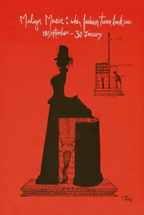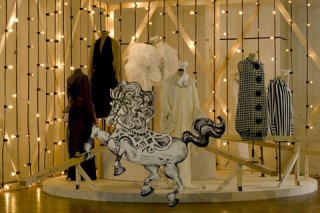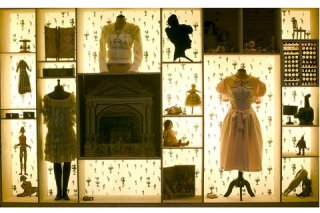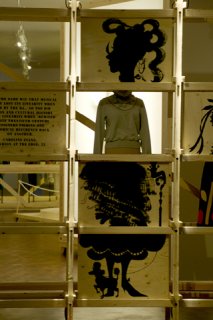Malign Muses, When Fashion Turns Back
"Malign Muses, When Fashion Turns Back" depicts in several ways how fashion and dress relate to their origin and past. Judith Clark, curator of the exhibition and architect by training, takes a personal look at the relationship between contemporary fashion and its history.
Clark states that fashion always has a sort of a love affair with its history and with former periods of style. "Malign Muses" is about re-enactment, recycling. But, when you look back, are things bigger or smaller? Is anything new?
"Malign Muses" is the first collaboration between the Fashion Museum Province of Antwerp ñ MoMu and the Victoria & Albert Museum in London. The exhibition contains a selection of items, both historical and contemporary, drawn from the permanent collections of the Fashion Museum and the Victoria & Albert Museum, as well as from the archives of several designers.
"Malign Muses" opens from September 18th 2004 till January 30th 2005 and will be on at the Contemporary Space at the Victoria & Albert Museum from February 22nd 2005 till May 8th 2005, which makes it an entirely unique project.
MALIGN MUSES OR A STORY OF ENCOUNTERS
"Malign Muses" is the result of Judith Clarks work at the London College of Fashion and the Victoria & Albert Museum as joint research fellow in contemporary dress, and of the curatorial work Judith Clark carried out at her gallery Judith Clark Costume Gallery in London.
The exhibition and the catalogue are the result of the conversations between several artists, as though combined in a curatorís sketch book.
Caroline Evans, a costume historian and author of the book Fashion at the Edge, provided Judith Clark with the key concepts describing contemporary dress and fashion theory.
Sketches by the fashion illustrator and designer Ruben Toledo were integrated into the exhibition design.
Judith Clark is inspired by shadows and outlines, like the atmosphere evocative of the magic lantern. Judith Clark was also inspired by the avant-garde architect Yuri Avvakumov and his skeletal structures which she has used as the basis for the installations.
The mannequins and busts were styled by the jewellery designer Naomi Filmer, who does not decorate the body but fills in its gaps.
SCENOGRAPHY
"Malign Muses" is thus not strictly a fashion exhibition, but rather Judith Clarkís personal interpretation and an experiment where she enters into discussion with fashion, architecture, illustration and so on. The exhibition explores how ëcurating dressí can be handled or understood. Judith Clarks answer is explicit: ìCurating is like creating a new grammar, new patterns of time and reference ...î
As an independent researcher at the Victoria & Albert Museum in London, Judith Clark conceives the exhibition as a utopian city, a work-in-progress comprising wooden structures and seemingly unfinished constructions ñ almost like blown-up models. In this way Clark creates a collage of visual effects and references, thereby giving a fascinating glimpse into such themes as alienation, trauma and remembrance ... For this purpose, she uses ëenvironmentalí metaphors inspired by the work of philosopher Walter Benjamin, such as the labyrinth, phantasmagoria, telescope and diorama.
This exhibition brings past and present together in a variety of settings: the collective fashion heritage is reflected by eight installations or suggestions in which the curator deals with fashion and its historical context from various angles: a detail of a historical costume may be viewed from a distance, while in other places past and present are ëreconciledí in an installation. These installations remind us of 19th- and early 20thcentury fairgrounds and the optical illusions seen in the theatre of that period.
THE EXHIBITION IS DIVIDED INTO 8 THEMATIC SECTIONS.
1. REAPPEARANCES: GETTING THINGS BACK
This first section looks at patterns of historical dress, where motifs return; when this occurs time folds back on itself forming a labyrinthine pattern. The viewer is given the opportunity to look through optical devices and pick out details of dress close up, bringing distorted elements into the present and forgetting their context, thereby alluding to the haunting of contemporary dress by its past. Seven views are set up for the visitor: magnifying, reflecting, selecting, doubling the objects through the peep holes reminding us of ílooking gamesí, phenakistoscope, zoetrope, or kaleidoscope. The geometric panorama of the labyrinth hides behind a wall Infinity alluded to by the lines of the labyrinth, in ever smaller patterns of return. By means of peepholes, curator Clark shows the visitor possible routes and patterns. The complex chaos is structured and connections between different silhouettes are all of a sudden visible.
2. NOSTALGIA Here the past is idealised into monuments. Taken from Ruben Toledoís avenue of silhouettes, giant wooden figures loom above the visitor. The exhibition questions whether nostalgia is hoping for a forgotten past or longing for impossible past futures ñ alternative histories. We are not sure whether the silhouettes are those of historical dresses or of designs for future dresses.
3. COGS - LOCKING IN AND OUT The past is brought into the foreground through literal quotation of its motifs, silhouettes, decoration. Where past and present pieces meet or interlock, there is an uncanny recognition, when they again diverge the past appears again remote. Six themes are acted out on three huge cogs, incessantly moving as a motif for the fashion system itself, promiscuous in its references. Fashion canít afford to get stuck anyway, but it also canít afford to be predictable. The question is how does fashion keep unlocking itself.
4. PHANTASMAGORIA The circus, a fairground and magic are the basis of the fourth thematic section of the exhibition. In three sections, tricks are shown as part of a circus act, a fairground activity and as transformative magic. A disused merry go round provides the structure for mannequins, spokes jutting out into the space, one of them ending in the silhouette of a fairground horse drawn by Ruben Toledo, and another ending in a cup, an image which is clearly related to the fairground as such. In the second part a marionette theatre is built exploring designers use of the harlequin pattern, the third shadows provide the inspiration for black figures. A shadow lantern is built holding four historical garments within it, the shadow show allows their exaggerated outlines to come through, losing all their decorative detail. In the fantasy past clothes can be anything we want them to be.
5. COLLAGE Fashion is often shamelessly irreverent in it uses of the past. Styling into the present often means literally combining the old and the new, the formal and the inappropriate, the trivial and the elegant. Old themes are worn as new details. In the fifth part of the exhibition the visitor looks at a set of cards, based on the Victorian card games of the ìhappy familyî, where limbs from the different members of the family are in a strange manner being combined. Ruben Toledo creates the feel of a 2D game as though we were free to change the combinations. New styles and silhouettes are constructed out of this combination, a different equation this time giving the wearer/curator creative leave to play.
6. A NEW DISTRESS The worn out, the scrapped, the torn apart, or burned and stained; are the material for the new distress. Distress here meaning both the sign of trauma and the evidence of wear and tear. In repeating these bits and pieces a disturbing past is being referred to; something ruined is being recovered. We find a use for the things we had discarded and are intrigued by what is beautiful about them. Unconserved dresses are placed on great tables, as if on the operating table of a giant dollís hospital. Oversized clinical tools designed by Toledo are placed next to decayed dress. Naomi Filmer turns broken limbs into precious objects of desire. Contemporary dress takes its inspiration from aging of the fabric itself, a different kind of history. Tears, stains here become the Muses.
7. GARDEN OF THE FORKING PATHS ìI imagined a labyrinth of labyrinths, a maze of mazes, a twisting, turning, ever-widening labyrinth that contained both past and future and somehow implied the starsÖI saw it- the garden of the forking paths was the chaotic novel; the phrase ëseveral futures (not all)í suggested to me the image of a fork in time, rather than in spaceÖIn all fictions, each time a man meets diverse alternatives, he chooses one and eliminates the others; in the work of Tsíui Pen, the character chooses ñ simultaneously ñ all of themÖ..The Garden of the Forking Paths is an incomplete, but not false, image of the universe as conceived by Tsíui Pen. Unlike Newton and Schopenhauer, your ancestor did not believe in a uniform and absolute time; he believed in an infinite series of times, a growing dizzying web of divergent, convergent and parallel times. That fabric of times that approach one another, fork, are snipped off, or are simply unknown for centuries, contains all possibilitiesÖî (The Garden of the Forking Paths; J-L Borges, Ficciones)
In the dramatic circular room of MoMu, a tree will be built out of scaffold, literally the family tree for one garment. Continuing the garden theme, floral decoration will be the link traced between garments. As though presenting parallel future for one garment.
8. ALICE IN WONDERLAND In the last part of the exhibition there are three chairs in different large sizes, on which a porcelain doll, a child mannequin and an adult mannequin are sitting, dressed in a childís clothes, to symbolize that one could ëplayí with age and time. The catalogue, entitled Spectres, When Fashion Turns Back, is published by V&A Publications (compiled by Judith Clark, with an introduction by Chris Breward and essays by Judith Clark, Caroline Evans and Yuri Avvakumov) and will appear in October 2004.
"Malign Muses, When Fashion Turns Back" will show the work of the following fashion houses and designers :
Junya Watanabe
Dries Van Noten
Bruno Pieters
Bernhard Willhelm
Walter Van Beirendonck
Dirk Van Saene
Veronique Branquinho
Jurgi Persoons
Christian Lacroix
Elsa Schiaparelli
Madame GrËs
Viktor & Rolf
Angelo Figus
A.F. Vandevorst
Pierre Cardin
Simon Thorogood
Hussein Chalayan
Shelley Fox
Comme des garÁons
Jean-Paul Gaultier
Maison Martin Margiela
Dior
Jean DessËs
Mary Quant
Helmut Lang
Hamish Morrow
Dai Rees
Olivier Theyskens
BIOGRAPHY
JUDITH CLARK
Judith Clark trained as an architect, at the Bartlett School of Architecture and Architectural Association in London. She founded Judith Clark Costume Gallery in 1998 dedicated to exhibiting dress. In 2002 she moved to the Victoria and Albert Museum as a London College of Fashion Research Fellow. Clark is a visiting lecturer on issues of dress display. Published texts include: Satellites of Fashion, Crafts Council, catalogue essay Radical Fashion, V&A, catalogue essay Addressing the Century: 100 years of Art and Fashion, catalogue Essay Backstage (MoMu); catalogue essay Wandering Allusions; essay in N?C Magazine featuring Hussein Chalayan Contributor to Fashion Theory Journal
CAROLINE EVANS
Caroline Evans studies ëHistory and Theory of Artí at the University of Sussex. She is Reader in Fashion Studies at Central Saint Martins College of Art and Design in London. She published ëFashion at the Edge: Spectacle, Modernity and Deathlinessí (2003) and ëWomen & Fashion: A new lookí (1989) and different articles and essays. Current research activities: Researching a book on the early history of fashion models and fashion shows.
NAOMI FILMER
Naomi Filmer studied Goldsmithing, Silversmithing, Metalwork and Jewellery at the Royal College of Art and at the Wolverhampton Polytechnic in Great Britain. She collaborated on several publications on fashion and Jewellery. She teaches Metalwork and Jewellery at the Royal College of Art en works regularly as consultant and designer of jewellery for different fashion houses; Alexander McQueen, Swarovski, Tristan Webber, Julien MacDonald and Hussein Chalayan. Finally, she collaborates on exhibitions, for example in 2003 ëTROPí at the MusÈe de la Mode et du Textile, Paris
YURI AVVAKUMOV
Yuri Avvakumov graduated from the Moscow Architecture Institute in 1981. He took part in architectural competitions, including Style for the year 2001, A+U, 1984 (1st Prize). Avvakumov reintroduced the term PAPER ARCHITECTURE to describe the genre of conceptual design in the USSR of the 1980s. He presents his work in several exhibitions and contributes to group exhibitions in Moscow, Tokyo, London, Paris ... At this moment he also teaches at the Utopia Foundation, Moscow.
RUBEN TOLEDO
Ruben Toledo was born in Havana, Cuba in 1961. He is at once a painter, sculptor, illustrator, fashion chronicler and critic, and surrealist wit. The changing posture of fashion and the body language of style are two of his constant obsessions and appear as themes throughout his work. He has also created witty and incisive illustrations for the top fashion magazines and journals from around the world, among them The New Yorker, Vogue, Harper's Bazaar and The New York Times. He has created numerous images and art installations for Louis Vuitton, Burberry, Tiffany&Co., Barneys New York among others. Toledo's work has been on exhibit throughout the world, including the Metropolitan Museum of Art in New York City, as well as several one man shows and exhibitions. Ruben Toledo is the author of ëStyle Dictionaryí a collection of his drawings and watercolors. He completed his first film entitled ëFashionationí in 2004.
I hope this catalogue is available on V&A's web site. Sounds like a fantastic concept. I think the past is definitely something that weighs heavily amongst creative designers.
[attachmentid=27218]















 .
.
